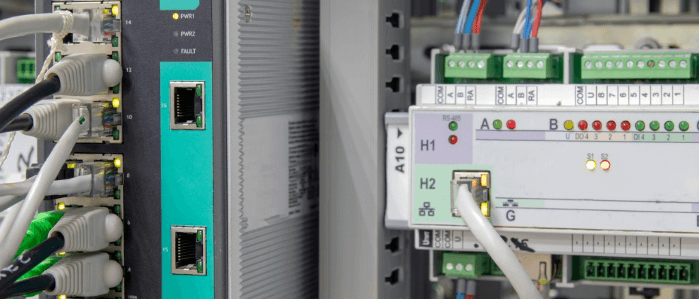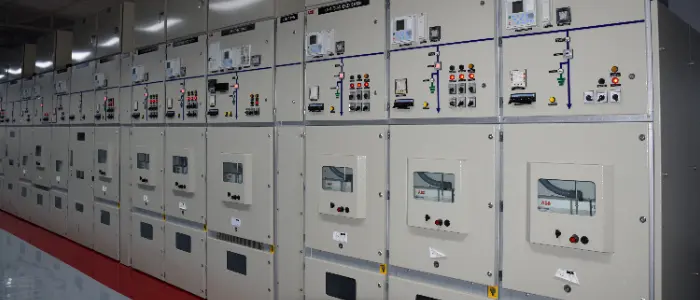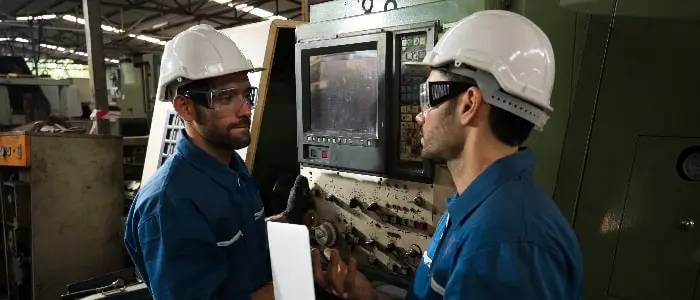24VDC Battery Backup for PLC Systems
Published on : 09 April 2022

PLC systems today are widely considered the brain behind a thriving plant or even standalone machine operation. Complementing them is a 24VDC power supply that integrates and supplements various control devices, sensors and auxiliaries throughout the PLC network running the system at optimum level.
Programmable Logic Controllers (PLCs) have proved their efficiency over the years. They are globally trusted for their rugged build, while being lightweight and easy to use. These are essentially computers, which are used to automate industrial processes such as wastewater treatment plants, ore processing plants, and manufacturing plants assembly lines.
From the early application days, PLCs had been designed to perform logical decisions for different electro-mechanical control applications. They were also expected to reliably operate in demanding industrial environments ranging from extreme low or high temperatures, and dust-prone conditions. Given the task at hand, PLCs can automate an entire production line or a particular machine function, or a given process.
All PLC units consist of four basic components. These components include the Processor section, an Input/Output (I/O) section, a programming section, and the power supply. The power supply provides the appropriate voltages levels required to power on the PLC and its internal components. It accomplishes this by converting a line voltage, mainly 240VAC (Alternating Current), into the required DC (Direct Current). The standard for an efficiently running PLC is 24VDC.
PLC’s Power Supply Matrix
Over the years, manufacturers have designed PLCs as highly rugged and robust in order to fulfill the promise of longevity, reliability and safety. However, their reliability is largely dependent on a reliable source of power. The high performance levels demanded of a PLC is dependent on the level of reliability offered by the specific process being monitored and controlled.
With such a dynamic and important responsibility on the shoulders of these controllers, it is imperative to have a reliable power supply solution that keeps system failures at bay. The power supply to PLCs consists of a step-down transformer that steps down the line voltage, along with a rectifier that converts it to DC.
The power of a PLC will largely depend on how reliable and strong the power supply is. The PLC power supply converts a line voltage into a usable 24 VDC voltage, to power on the PLC and its components. The linear voltage is usually 120 or 240 volts AC.
There are capacitors available for the unit that filter the DC current. This ensures a constant supply of output voltage devoid of electrical noise and transient voltage spikes. While the primary source of power for the PLC and its components is the main power supply, the PLC also consists of a battery backup. Few PLC models have the main power supply unit charge the internal battery, which is directly connected to the PLC CPU board.
The Need for a Continued Power Supply
Some operational processes may not be disrupted if there is a complete loss of power to the PLC. These merely require the controller to reboot when power resumes. However, in other applications, the PLC must remain fully functional to allow the process to continue and migrate to a known state even after a complete loss of power.
The PLC, like many other types of microprocessor-based equipment, has an internal switch mode power supply. A standard PLC is powered by a standard AC utility source, or from a 24VDC power source. From these sources, the power supply creates highly regulated DC voltages. It is vital for the proper functioning of the PLC’s internal CPU, volatile memory chips and all of the other internal PLC electronics.
These DC output voltages are calibrated to remain within regulation over a wide utility voltage range. However, the acceptable voltage range is not infinite. Once the input voltage is out of its normal operational range, the critical DC output voltages will go out of regulation, causing the PLC to malfunction. Low input line voltage conditions or momentary or sustained voltage dropouts often cause the above condition.
Usages of 24VDC Power Supply in PLC Systems
A PLC is a controller containing an IO model and network and there are field sensors. These mostly operate on a low voltage: 24VDC. Normally the input supply is a 240VAC UPS that powers the PLC. The PLC gets the information regarding all the signals exchanged on the field through potential free contact from the 24VDC’s modem.
Widely regarded as the blood circulating through all essential PLC components, a 24VDC is cleverly designed to overcome any long distance signal wire v-drop to carry a 4-20ma signal of precise value. It is also robust enough to power smart transmitters across a distance similar to those that provide Modbus communication.
Operators get the option to insert a low watt resistor across the input card input terminals to convert the 4-20ma signal to a voltage signal such as 1-5 VDC if required. As has been proven, the 24 VDC power systems are safe for live power work. Operators can manage them for seamlessly inserting IS barriers if required, to enter power loops into class 1 Zone 1 and 2 hazardous areas. Also, there are IEC, IEEE, ISA standards and specifications that standardize the 24 VDC loops.
Current Challenges of Power Supply In PLC Systems
The reliability of PLC-based control systems is dependent on having an uninterrupted power source. Power supply issues can result from multiple reasons, including loose or corroded cables and power supply fluctuations.
As a norm, many manufacturing facilities, utilities and infrastructure companies generally have redundant power systems or install uninterruptible power supplies (UPS). With such an arrangement in place, a part of the plant continues to function even in the event of a mains power failure. This provides control over essential items and helps maintain operational safety.
Even if an industrial plant considers a UPS nonessential and a complete process stop is manageable in the event of a power outage, a PLC’s memory can be lost when power fails. This can not only lead to loss of process data, but also a complete loss of active programs. To prevent this, a PLC occasionally employs its own backup battery to ensure the device restarts correctly when power is restored.
Failure to maintain and replace the batteries in a PLC or UPS can lead to a major system failure in the event of a power outage. Companies must periodically back up the PLC software and store it securely. Failure to do so makes it incredibly difficult to resume normal functionalities during PLC memory loss. Furthermore, it turns a minor power loss instance into a major downtime issue.
The concern today is that a 24VDC does not come with a backup and this warrants the use of a UPS. Over the years, the UPS has emerged as a critical and essential component in the efficient functioning of a PLC. An SMPS is employed here, which takes inputs from the UPS and converts 240VAC to 24VDC.
Till date, 24VDC units have run through AC as a standalone supply without the need for a backup. AC UPS power is not possible everywhere. Remote sites, Sewage /Water pumping stations, Far away Borewells areas or sometimes not enough UPS capability is available in centralized UPS.
DC UPS: Leading the Future
To address this issue, IndAXonline has made available a battery backup for 24VDC. The idea is that SMPS should run independently on a battery setup without the need for a UPS. This eliminates the dependency of the 24VDC on the UPS through the new path breaking 24DC UPS.
The company can provide SMPS strength with a battery. This negates the need for a UPS power supply everywhere and everytime. Also, it provides inputs concerning the status of the PLC with regards to low battery warning, remaining battery backup and any system failures in the course of operations.
PLC units need DC UPS power supply to bridge a mains failure so that machines continue to run uninterrupted. Also, a need to shut down the IPC or system in a controlled manner will always arise as and when there is a mains failure. Power failures lasting for even a few seconds can disrupt sensitive processes.
The latest technology from IndAXonline offers a variety of different DC-UPS modules for the controlled shutdown of plants, PCs, and IPCs. It also allows the successful bridging of power failures lasting from several minutes to several days. This prevents data losses, production outages, and damage to products, etc. An efficient DC UPS ensures an operator is optimally equipped for a 24-VDC uninterruptible power supply.




